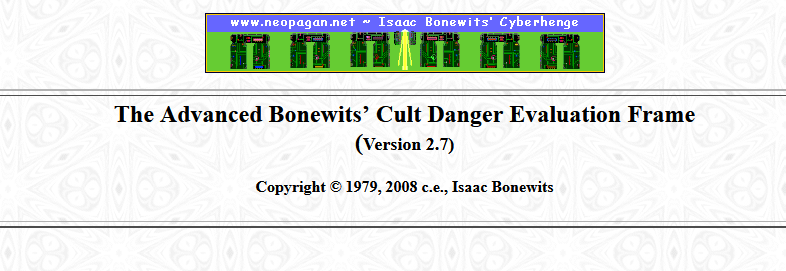
The Advanced Bonewits’ Cult Danger Evaluation Frame (Version 2.6)

Originally by: Isaac Bonewits.
Introduction
Events in the last several decades have clearly indicated just how dangerous some religious and secular groups (usually called “cults” by those opposed to them) can be to their own members as well as to anyone else whom they can influence. “Brainwashing,” beatings, child abuse, rapes, murders, mass suicides, military drilling and gunrunning, meddling in civil governments, international terrorism, and other crimes have been charged against leaders and members of many groups, and in far too many cases those accusations have been correct. None of this has been very surprising to historians of religion or to other scholars of what are usually labeled “new” religions (no matter how old they may be in their cultures of origin). Minority groups, especially religious ones, are often accused of crimes by members of the current majority. In many ways, for example, the “Mormons” were the “Moonies” of the 19th century — at least in terms of being an unusual minority belief system that many found “shocking” at the time — and the members of the Unification Church could be just as “respectable” a hundred years from now as the Latter Day Saints are today.
Nonetheless, despite all the historical and philosophical warnings that could be issued, ordinary people faced with friends or loved ones joining an “unusual” group, or perhaps contemplating joining one themselves, need a relatively simple way to evaluate just how dangerous or harmless a given group is liable to be, without either subjecting themselves to its power or judging it solely on theological or ideological grounds (the usual method used by anti-cult groups).
In 1979 I constructed an evaluation tool which I now call the “Advanced Bonewits’ Cult Danger Evaluation Frame” or the “ABCDEF” (because evaluating these groups should be elementary). A copy was included in that year’s revised edition of my book, Real Magic. I realize its shortcomings, but feel that it can be effectively used to separate harmless groups from the merely unusual-to-the-observer ones. Feedback from those attempting to use the system has always been appreciated. Indirect feedback, in terms of the number of places on and off the Net this ABCDEF has shown up, has been mostly favorable. For example, it was chosen by and is now displayed on the website of the Institute for Social Inventions, who paraphrased it for their “Best Ideas — A compendium of social innovations” listing.
The purpose of this evaluation tool is to help both amateur and professional observers, including current or would-be members, of various organizations (including religious, occult, psychological or political groups) to determine just how dangerous a given group is liable to be, in comparison with other groups, to the physical and mental health of its members and of other people subject to its influence. It cannot speak to the “spiritual dangers,” if any, that might be involved, for the simple reason that one person’s path to enlightenment or “salvation” is often viewed by another as a path to ignorance or “damnation.”
As a general rule, the higher the numerical total scored by a given group (the further to the right of the scale), the more dangerous it is likely to be. Though it is obvious that many of the scales in the frame are subjective, it is still possible to make practical judgments using it, at least of the “is this group more dangerous than that one?” sort. This is if all numerical assignments are based on accurate and unbiased observation of actual behavior by the groups and their top levels of leadership (as distinct from official pronouncements). This means that you need to pay attention to what the secondary and tertiary leaders are saying and doing, as much (or more so) than the central leadership — after all, “plausible deniability” is not a recent historical invention.
This tool can be used by parents, reporters, law enforcement agents, social scientists and others interested in evaluating the actual dangers presented by a given group or movement. Obviously, different observers will achieve differing degrees of precision, depending upon the sophistication of their numerical assignments on each scale. However, if the same observers use the same methods of scoring and weighting each scale, their comparisons of relative danger or harmlessness between groups will be reasonably valid, at least for their own purposes. People who cannot, on the other hand, view competing belief systems as ever having possible spiritual value to anyone, will find the ABCDEF annoyingly useless for promoting their theological agendas. Worse, these members of the Religious Reich and their fellow theocrats will find that their own organizations (and quite a few large mainstream churches) are far more “cult-like” than many of the minority belief systems they so bitterly oppose.
It should be pointed out that the ABCDEF is founded upon both modern psychological theories about mental health and personal growth, and my many years of participant observation and historical research into minority belief systems. Those who believe that relativism and anarchy are as dangerous to mental health as absolutism and authoritarianism, could (I suppose) count groups with total scores nearing either extreme (high or low) as being equally hazardous. As far as dangers to physical well-being are concerned, however, both historical records and current events clearly indicate the direction in which the greatest threats lie. This is especially so since the low-scoring groups usually seem to have survival and growth rates so small that they seldom develop the abilities to commit large scale atrocities even had they the philosophical or political inclinations to do so.
The Advanced Bonewits’ Cult Danger Evaluation Frame (version 2.6)
| 1 2 3 4 5 6 7 8 9 10 Low …………………. High |
|
| Internal Control – Amount of internal political and social power exercised by leader(s) over members; lack of clearly defined organizational rights for members. | 1 2 3 4 5 6 7 8 9 10 Low …………………. High |
| External Control: Amount of external political and social influence desired or obtained; emphasis on directing members’ external political and social behavior. | 1 2 3 4 5 6 7 8 9 10 Low …………………. High |
| Wisdom/Knowledge Claimed by leader(s); amount of infallibility declared or implied about decisions or doctrinal/scriptural interpretations; number and degree of unverified and/or unverifiable credentials claimed. | 1 2 3 4 5 6 7 8 9 10 Low …………………. High |
| Wisdom/Knowledge Credited to leader(s) by members; amount of trust in decisions or doctrinal/scriptural interpretations made by leader(s); amount of hostility by members towards internal or external critics and/or towards verification efforts. | 1 2 3 4 5 6 7 8 9 10 Low …………………. High |
| Dogma: Rigidity of reality concepts taught; amount of doctrinal inflexibility or “fundamentalism;” hostility towards relativism and situationalism. | 1 2 3 4 5 6 7 8 9 10 Low …………………. High |
| Recruiting: Emphasis put on attracting new members; amount of proselytizing; requirement for all members to bring in new ones. | 1 2 3 4 5 6 7 8 9 10 Low …………………. High |
| Front Groups: Number of subsidiary groups using different names from that of main group, especially when connections are hidden. | 1 2 3 4 5 6 7 8 9 10 Low …………………. High |
| Wealth: Amount of money and/or property desired or obtained by group; emphasis on members’ donations; economic lifestyle of leader(s) compared to ordinary members. | 1 2 3 4 5 6 7 8 9 10 Low …………………. High |
| Sexual Manipulation of members by leader(s) of non-tantric groups; amount of control exercised over sexuality of members in terms of sexual orientation, behavior, and/or choice of partners. | 1 2 3 4 5 6 7 8 9 10 Low …………………. High |
| Sexual Favoritism: Advancement or preferential treatment dependent upon sexual activity with the leader(s) of non-tantric groups. | 1 2 3 4 5 6 7 8 9 10 Low …………………. High |
| Censorship: Amount of control over members’ access to outside opinions on group, its doctrines or leader(s). | 1 2 3 4 5 6 7 8 9 10 Low …………………. High |
| Isolation: Amount of effort to keep members from communicating with non-members, including family, friends and lovers. | 1 2 3 4 5 6 7 8 9 10 Low …………………. High |
| Dropout Control: Intensity of efforts directed at preventing or returning dropouts. | 1 2 3 4 5 6 7 8 9 10 Low …………………. High |
| Violence: Amount of approval when used by or for the group, its doctrines or leader(s) | 1 2 3 4 5 6 7 8 9 10 Low …………………. High |
| Paranoia: Amount of fear concerning real or imagined enemies; exaggeration of perceived power of opponents; prevalence of conspiracy theories. | 1 2 3 4 5 6 7 8 9 10 Low …………………. High |
| Grimness: Amount of disapproval concerning jokes about the group, its doctrines or its leader(s). | 1 2 3 4 5 6 7 8 9 10 Low …………………. High |
| Surrender of Will: Amount of emphasis on members not having to be responsible for personal decisions; degree of individual disempowerment created by the group, its doctrines or its leader(s). | 1 2 3 4 5 6 7 8 9 10 Low …………………. High |
| Hypocrisy: amount of approval for actions which the group officially considers immoral or unethical, when done by or for the group, its doctrines or leader(s); willingness to violate the group’s declared principles for political, psychological, social, economic, military, or other gain. | 1 2 3 4 5 6 7 8 9 10 Low …………………. High |
| 1 2 3 4 5 6 7 8 9 10 Low …………………. High ___________________________ |















Recent Comments